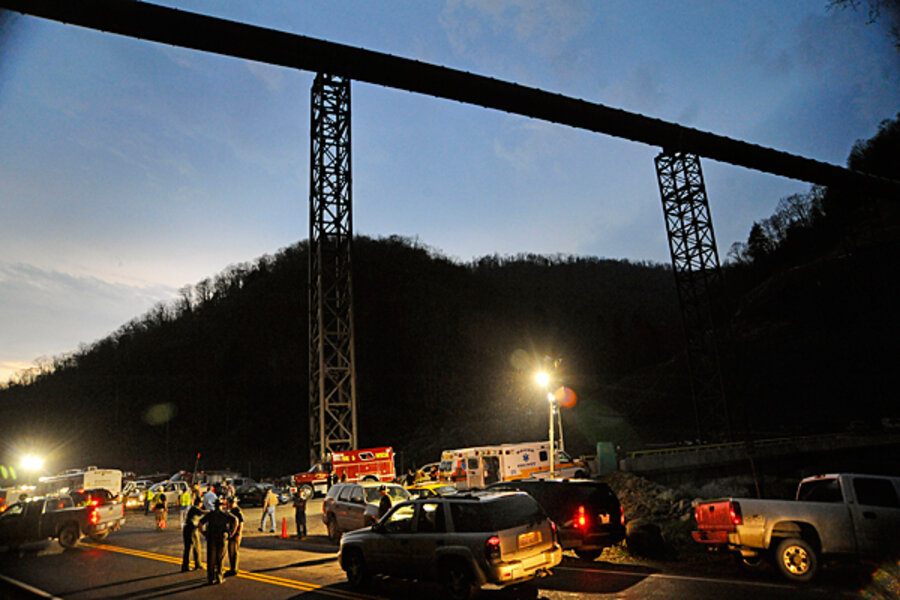Months after W.V. coal mining disaster, new US rule on coal dust
Loading...
The Obama administration has issued an emergency order to underground mine operators to strengthen a crucial safety measure to prevent explosions of coal dust, a highly flammable substance that has been blamed for deadly mine disasters for decades.
Investigators say coal dust likely was a key factor in the April 5 explosion at the Upper Big Branch Mine in Raleigh County, W.Va., that killed 29 people, considered the worst US coal-mining disaster in 40 years.
The emergency order, issued on Tuesday by the US Mine Safety and Health Administration (MSHA), will force mine operators to increase the amount of incombustible “rock dust” that is applied across walls, floors and all other surfaces of their underground operations.
IN PICTURES: West Virginia mine explosion
Rock dust, a mixture usually consisting of powered limestone, is known to destabilize coal dust, a discharge from drilling that is highly explosive. Compliance with the order is expected by Nov. 22.
“Coal dust explosions are serious, and we expect mine operators to act quickly to reduce the threat to those mining coal underground,” Joseph Main, assistant secretary of labor for mine safety and health, said in a statement.
Until this week, mining companies were required to apply enough of the incombustible material so that 65 percent of the particles suspended in the air pumped out of the mine was rock dust. But five years ago the National Institute for Occupational Safety and Health [NIOSH] started testing the durability of that level and found that modern drilling techniques were shearing the coal into a much finer and more dangerous dust, which, if ignited, can impact a much broader area underground.
The emergency order raises the level of rock dust suspended in the mines’ expelled air to 80 percent. According to Larry Grayson, a former miner who teaches mineral engineering at Penn State in University Park, Pa., the previously recommended levels of rock dust “will stop an explosion from spreading” but not stop the initial explosion. The higher level, he says, “will prevent the explosion.”
Mr. Grayson says the new regulation is not expected to financially burden the industry because the majority of mines already are in compliance. “No one is questioning it,” he says.
However the new regulation has resonance because of its timing in relation to the Upper Big Branch explosion.
Three independent investigations are working to determine the cause of the Upper Big Branch Mine explosion. While none have yet to publish a conclusive report, indications are that all three suggest coal dust is a central focus.
Davitt McAteer, who was the lead investigator of the 2006 disaster in Sago, W.Va. that killed 13 miners, calls the US Mine Safety and Health Administration ruling “a significant step” in raising US mining safety standards.
“It’s been recognized for some years now that the [current] regulation was outdated and needed to be replaced,” he said. Mr. McAteer, who was appointed by W.Va. Governor Joe Manchin to lead an independent investigation of the April disaster, says the explosion at the Upper Big Branch Mine “pointed out dramatically … that coal dust needs to be made inert.”
Upper Big Branch Mine operator Massey Energy Co. of Richmond Va. is suggesting the explosion came about by natural forces. The company says a breach in the mine’s floor allowed a massive rush of methane gas to escape and that two handheld methane detectors recovered from the site recorded maximum readings of methane and carbon monoxide. The simultaneous surge in readings took place within seconds of the other on the day of the explosion, the company says.
Kevin Stricklin, an administrator with MSHA, told victim families at a briefing last month outside Beckley, W.Va. that it was too early to determine if a methane outburst ignited the blast. He outlined certain safety measures, such as ventilation technology and equipment protection, that would have prevented such a scenario, suggesting that Massey would still be responsible if the company’s reasoning proved accurate.
“Explosions are preventable,” Mr. Stricklin said.





